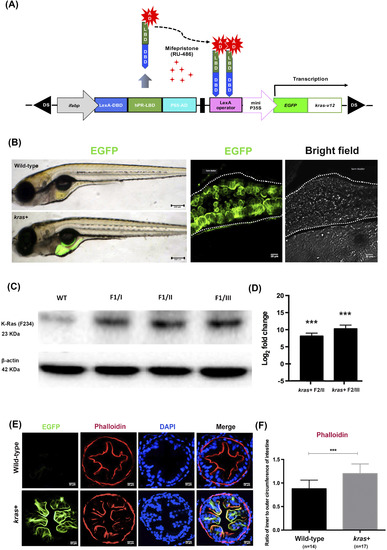
Generation and characterization of Tg(ifabp:EGFP-krasV12) transgenic zebrafish. (A) Schematic diagram showing the DNA pDs-ifabp:LexPR-Lexop:EGFP-krasV12 construct used for the generation of Tg(ifabp:EGFP-krasV12) transgenic fish. Ds, maize Ds transposon sequence. (B) Intestine-specific expression of EGFP-krasV12 in F1 transgenic fry and wild-type fish, and confocal image of whole mounted kras+ transgenic larva at 8 dpf following induction by 1 μM Mifepristone. The images were obtained at z = 5 μm over a thickness of 50 μm. (C) Western blot analysis of total proteins from WT and kras+ transgenic fish in the gut tissue from three founder lineage (I, II, and III) for the detection of the Kras protein. β-Actin, internal control for equal loading. (D) RT-qPCR analysis of kras RNA expression in the kras+ transgenic F2 whole larvae from founders I and III. N = 20 larvae from each founder (at 2 dpi using 1 μM mifepristone) were used for isolation of proteins and mRNA. (E) Fluorescence micrographs of intestine cross sections from wild-type and kras+ zebrafish larvae showing green fluorescence or phalloidin staining. (F) Quantification of villi by ratio of inner to outer circumferences of intestine at 10 dpi by 2 μM mifepristone. Statistical significance: ***P < .001.
|

